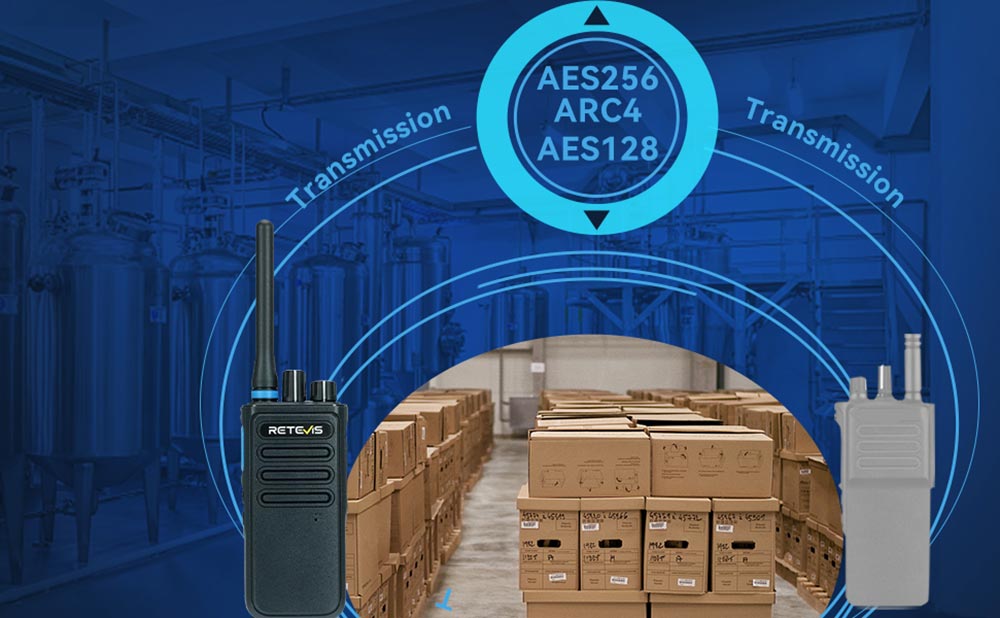About Retevis P1 High Power DMR Walkie Talkie AES256 Encryption

About Retevis P1 High Power DMR Walkie Talkie AES256 Encryption
Millions of businesses and organizations rely on business walkie talkie communications to maintain normal operations. There are many situations where commercial two-way radio users need their radio transmissions to be free from interference and/or prying eyes. This is where two-way radio encryption comes in, and the Retevis P1 AES256 UHF DMR Walkie Talkie is an encrypted radio. It can better help you face interference and prying.
This article explains what AES-256 encryption is, how it works, and how secure it is.
What is AES256?
Advanced Encryption Standard (AES) is the symmetric block cipher chosen by the United States government to protect classified information. It is critical to government computer security, cybersecurity and electronic data protection. Initially adopted by the U.S. federal government, the Advanced Encryption Standard (AES) has grown to become an industry standard for keeping data secure and required to be part of every organization's integrated risk management strategy. AES is available in 128-bit, 192-bit, and 256-bit implementations, with the 256-bit implementation being the most secure.
AES256 Working Principle
It works by taking plain text or data and using a key to convert it into a code called a password. A cipher is an unreadable and ineffectively decipherable text that is incomprehensible to both humans and computers. AES-256 encryption uses a 256-bit key length to encrypt and decrypt message blocks. There are 14 rounds of 256-bit keys, each round containing processing steps that require replacing, transposing, and mixing the plaintext to convert it into ciphertext.
The algorithm consists of six steps:
Key expansion − In this phase, the round key is created for use in the next phase of encryption. This uses Rijndael's key schedule.
Round Key Addition - A round key is the result of an operation on the previous round key and the data to be encrypted. In this step, the initial round key is added to the partitioned data.
Byte Substitution - Switches bytes according to the Rijndael S-Box substitution method.
Row Shift - The data divided into each row is shifted to the left (one space in the second row, two spaces in the third row, and three spaces in the fourth row).
Column Mixing - Using a predetermined matrix, multiply the data columns and create a new block of code.
Round Key Addition - Another round key is applied to the column.
The National Institute of Standards and Technology has chosen three "flavors" of AES: 128-bit, 192-bit, and 256-bit. Each type uses 128-bit blocks. The difference is the length of the key. As the longest key, a 256-bit key provides the strongest level of encryption. With a 256-bit key, a hacker would need to try 2256 different combinations to ensure the correct one is included. The number is astronomical, reaching 78 in total. It is much larger than the number of atoms in the observable universe. Understandably, the U.S. government requires 128-bit or 256-bit encryption for sensitive data.
The three AES variants are also distinguished by the number of encryption rounds. AES 128 uses 10 rounds, AES 192 uses 12 rounds, and AES 256 uses 14 rounds. The more rounds there are, the more complex the encryption becomes, making AES 256 the most secure AES implementation. It should be noted that the longer the key and the more rounds, the higher the performance requirements. AES 256 uses 40% more system resources than AES 192, making it best suited for highly sensitive environments where security is more important than speed
Advantages of encrypted two way radio

The benefits of two-way radio encryption are immeasurable. For example, law enforcement agencies, the military, and EMS and other emergency services personnel rely on two-way communications to ensure public safety and well-being. Encrypted two-way radios are also common in the construction, manufacturing and transportation industries. They are widely used in broadcast television and radio services, education, healthcare, entertainment, tourism, finance and countless other fields. Additionally, as technology continues to advance, data, information, and overall privacy become increasingly accessible to unwanted third parties. Therefore, encrypted two-way radios are always a safe choice for any environment (business or private) that requires a secure line of communication.
Summarize
The Retevis P1 long range walkie-talkie uses AES256 encryption to better ensure the security of your communications. Let your business and organizational information be better protected.






